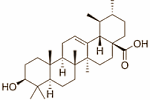|
Definition: "An ergogenic aid is any substance or phenomenon that enhances performance "
|
|
||||||||
05.08.2011 |
|
|
Ursolic acid: apple anabolic
The fatty layer on apple peel contains a compound that has an anabolic effect, write researchers from the University of Iowa in Cell Metabolism. It's called ursolic acid, but also goes by the shorter name of malol [structural formula shown below]. In tests on mice, the compound caused their muscles to grow and fat mass to shrink.
The researchers from Iowa stumbled upon the anabolic properties of ursolic acid when they were examining cells from muscle tissue that was wasting. They determined which genes in the cells were active during the process of muscular atrophy. Then they searched databases for substances that had precisely the opposite effect. The most promising substance that they found was ursolic acid.
The figures immediately below show that a five-week course of malol resulted in growth of the quadriceps and that the mice grew stronger. The activity of the catabolic genes MuRF-1 and Atrogin-1 declined in the muscle cells. In contrast, the activity of the gene for IGF-1 increased, as did the concentration of IGF-1 in the blood. Molecular signalling molecules, like the receptor for IGF-1, Akt and S6K, were switched on.
The figure above describes the effect on muscle and fat mass of seven weeks of supplementation with increasing doses of ursolic acid.
In the animal studies ursolic acid also reduced the fat cells' emission of leptin, the concentrations of triglycerides and cholesterol, and even the fasting glucose level. All of these are positive effects.
The researchers suspect that ursolic acid's prime target is the IGF-1 receptor. This becomes more sensitive and as a result the IGF-1 that is present in the body works better.
"Given the current lack of therapies for skeletal muscle atrophy, we speculate that ursolic acid might be investigated as a potential therapy for illness- and age-related muscle atrophy", the researchers conclude.
"It may be useful as a monotherapy or in combination with other strategies that have been considered, such as myostatin inhibition. A systematic search for ursolic acid derivatives that are more potent and/or efficacious could also be undertaken."
Source:
More:
|
|





